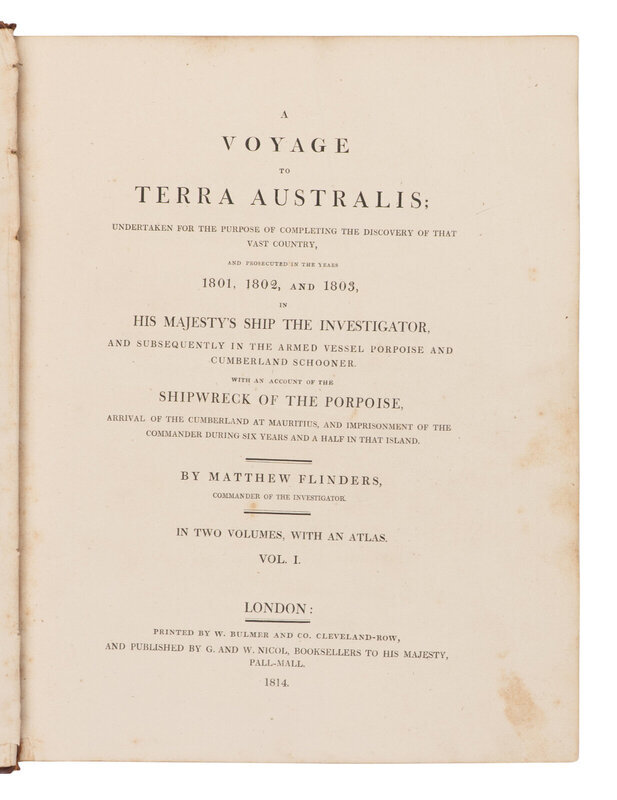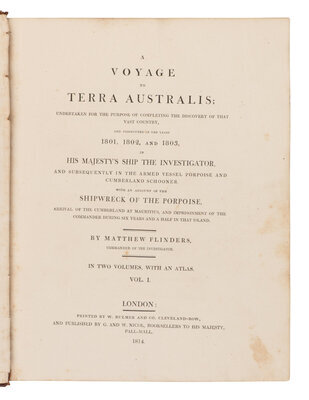Condition Report
Contact Information
Lot 230
Sale 6426 - Fine Printed Books & Manuscripts, Including Americana
Nov 13, 2025
10:00AM CT
Live / Chicago
Own a similar item?
Estimate
$2,500 -
3,500
Lot Description
[TRAVEL & EXPLORATION]. FLINDERS, Matthew (1774-1814). A Voyage to Terra Australis, undertaken for the purpose of completing the discovery of
that vast country, and prosecuted in the years 1801, 1802, and 1803, in His Majesty's Ship The Investigator and
subsequently in the armed vessel Porpoise and Cumberland schooner. London: W. Bulmer and Co. for G. and W. Nicol, 1814.
that vast country, and prosecuted in the years 1801, 1802, and 1803, in His Majesty's Ship The Investigator and
subsequently in the armed vessel Porpoise and Cumberland schooner. London: W. Bulmer and Co. for G. and W. Nicol, 1814.
Text only, 2 volumes (of 3, lacking atlas), large 4to (292 x 229 mm). Half-titles, 9 engraved plates by J. Byrne, John Pye, W. Woolnoth, I. Scott, Edward Finden, and S. Middiman after William Westall. (Spotting and toning to plates, some light marginal dampstaining to plates in vol.2, offsetting to text from plates, endpapers toned). Contemporary half calf, marbled boards, flat spines divided into six compartments by double gilt fillets, lettered in the second compartment, numbered in the fourth (rubbing to extremities). Provenance: D. Stansbury (penciled ownership inscription on half-title).
FIRST EDITION OF THE TEXT OF THE FLINDERS' MONUMENTAL WORK OF AUSTRALIAN EXPLORATION. Wantrup rightly calls this work "the most outstanding book on the coastal navigation of Australia," and "the centrepiece of any collection of books dealing with Australian coastal discovery."
"Flinders was the first commander to circumnavigate the Australian continent, and the first to give it its present name" (Hill). Flinders sailed from England on 18 July 1801, and during the next two years, he surveyed the entire south coast of Australia from Cape Leeuwin to Bass Strait, the east coast, and the Gulf of Carpentaria. He returned to Port Jackson in 1803, having completed the first circumnavigation of Australia. On the return journey, Flinders was detained by the French in Mauritius for six and a half years and was not released until June 1810. He devoted the remainder of his life to the publication of this work, which was formally published one day before his death on 19 July 1814. It is a day-by-day record of the expedition, including a lengthy introduction that details earlier South Seas voyages and an appendix by Robert Brown, the botanist who accompanied the expedition. Flinders took great pains to ensure the accuracy of the work, and the charts contained in the atlas were used for navigation for over a century. The two volumes of text were originally published in both large-paper and normal issues: the present set is from the regular-sized issue.
Ferguson 576; Hill (2004) 614; Ingleton 6487; Nissen BBI 637; Stafleu & Cowan I,1806; Wantrup Australian Rare Books, pp.138-144.
This lot is located in Chicago.

